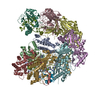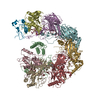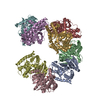[English] 日本語
 Yorodumi
Yorodumi- EMDB-22582: Cryo-EM structure of CRISPR-Cas surveillance complex with AcrIF4 -
+ Open data
Open data
- Basic information
Basic information
| Entry | Database: EMDB / ID: EMD-22582 | |||||||||
|---|---|---|---|---|---|---|---|---|---|---|
| Title | Cryo-EM structure of CRISPR-Cas surveillance complex with AcrIF4 | |||||||||
 Map data Map data | ||||||||||
 Sample Sample |
| |||||||||
 Keywords Keywords | CRISPR / HYDROLASE | |||||||||
| Function / homology |  Function and homology information Function and homology informationmaintenance of CRISPR repeat elements / endonuclease activity / defense response to virus / Hydrolases; Acting on ester bonds / RNA binding Similarity search - Function | |||||||||
| Biological species |   Pseudomonas phage sp. (virus) Pseudomonas phage sp. (virus) | |||||||||
| Method | single particle reconstruction / cryo EM / Resolution: 3.2 Å | |||||||||
 Authors Authors | Chang L / Li Z | |||||||||
 Citation Citation |  Journal: Nucleic Acids Res / Year: 2021 Journal: Nucleic Acids Res / Year: 2021Title: Structural basis for inhibition of the type I-F CRISPR-Cas surveillance complex by AcrIF4, AcrIF7 and AcrIF14. Authors: Clinton Gabel / Zhuang Li / Heng Zhang / Leifu Chang /  Abstract: CRISPR-Cas systems are adaptive immune systems in bacteria and archaea to defend against mobile genetic elements (MGEs) and have been repurposed as genome editing tools. Anti-CRISPR (Acr) proteins ...CRISPR-Cas systems are adaptive immune systems in bacteria and archaea to defend against mobile genetic elements (MGEs) and have been repurposed as genome editing tools. Anti-CRISPR (Acr) proteins are produced by MGEs to counteract CRISPR-Cas systems and can be used to regulate genome editing by CRISPR techniques. Here, we report the cryo-EM structures of three type I-F Acr proteins, AcrIF4, AcrIF7 and AcrIF14, bound to the type I-F CRISPR-Cas surveillance complex (the Csy complex) from Pseudomonas aeruginosa. AcrIF4 binds to an unprecedented site on the C-terminal helical bundle of Cas8f subunit, precluding conformational changes required for activation of the Csy complex. AcrIF7 mimics the PAM duplex of target DNA and is bound to the N-terminal DNA vise of Cas8f. Two copies of AcrIF14 bind to the thumb domains of Cas7.4f and Cas7.6f, preventing hybridization between target DNA and the crRNA. Our results reveal structural detail of three AcrIF proteins, each binding to a different site on the Csy complex for inhibiting degradation of MGEs. | |||||||||
| History |
|
- Structure visualization
Structure visualization
| Movie |
 Movie viewer Movie viewer |
|---|---|
| Structure viewer | EM map:  SurfView SurfView Molmil Molmil Jmol/JSmol Jmol/JSmol |
| Supplemental images |
- Downloads & links
Downloads & links
-EMDB archive
| Map data |  emd_22582.map.gz emd_22582.map.gz | 3.7 MB |  EMDB map data format EMDB map data format | |
|---|---|---|---|---|
| Header (meta data) |  emd-22582-v30.xml emd-22582-v30.xml emd-22582.xml emd-22582.xml | 19.3 KB 19.3 KB | Display Display |  EMDB header EMDB header |
| Images |  emd_22582.png emd_22582.png | 129.6 KB | ||
| Filedesc metadata |  emd-22582.cif.gz emd-22582.cif.gz | 6.8 KB | ||
| Archive directory |  http://ftp.pdbj.org/pub/emdb/structures/EMD-22582 http://ftp.pdbj.org/pub/emdb/structures/EMD-22582 ftp://ftp.pdbj.org/pub/emdb/structures/EMD-22582 ftp://ftp.pdbj.org/pub/emdb/structures/EMD-22582 | HTTPS FTP |
-Validation report
| Summary document |  emd_22582_validation.pdf.gz emd_22582_validation.pdf.gz | 400.5 KB | Display |  EMDB validaton report EMDB validaton report |
|---|---|---|---|---|
| Full document |  emd_22582_full_validation.pdf.gz emd_22582_full_validation.pdf.gz | 400.1 KB | Display | |
| Data in XML |  emd_22582_validation.xml.gz emd_22582_validation.xml.gz | 6.1 KB | Display | |
| Data in CIF |  emd_22582_validation.cif.gz emd_22582_validation.cif.gz | 7 KB | Display | |
| Arichive directory |  https://ftp.pdbj.org/pub/emdb/validation_reports/EMD-22582 https://ftp.pdbj.org/pub/emdb/validation_reports/EMD-22582 ftp://ftp.pdbj.org/pub/emdb/validation_reports/EMD-22582 ftp://ftp.pdbj.org/pub/emdb/validation_reports/EMD-22582 | HTTPS FTP |
-Related structure data
| Related structure data |  7jzwMC  7jzxC  7jzzC C: citing same article ( M: atomic model generated by this map |
|---|---|
| Similar structure data |
- Links
Links
| EMDB pages |  EMDB (EBI/PDBe) / EMDB (EBI/PDBe) /  EMDataResource EMDataResource |
|---|
- Map
Map
| File |  Download / File: emd_22582.map.gz / Format: CCP4 / Size: 65.5 MB / Type: IMAGE STORED AS FLOATING POINT NUMBER (4 BYTES) Download / File: emd_22582.map.gz / Format: CCP4 / Size: 65.5 MB / Type: IMAGE STORED AS FLOATING POINT NUMBER (4 BYTES) | ||||||||||||||||||||||||||||||||||||||||||||||||||||||||||||
|---|---|---|---|---|---|---|---|---|---|---|---|---|---|---|---|---|---|---|---|---|---|---|---|---|---|---|---|---|---|---|---|---|---|---|---|---|---|---|---|---|---|---|---|---|---|---|---|---|---|---|---|---|---|---|---|---|---|---|---|---|---|
| Projections & slices | Image control
Images are generated by Spider. | ||||||||||||||||||||||||||||||||||||||||||||||||||||||||||||
| Voxel size | X=Y=Z: 1.05 Å | ||||||||||||||||||||||||||||||||||||||||||||||||||||||||||||
| Density |
| ||||||||||||||||||||||||||||||||||||||||||||||||||||||||||||
| Symmetry | Space group: 1 | ||||||||||||||||||||||||||||||||||||||||||||||||||||||||||||
| Details | EMDB XML:
CCP4 map header:
| ||||||||||||||||||||||||||||||||||||||||||||||||||||||||||||
-Supplemental data
- Sample components
Sample components
-Entire : CRISPR-Cas complex
| Entire | Name: CRISPR-Cas complex |
|---|---|
| Components |
|
-Supramolecule #1: CRISPR-Cas complex
| Supramolecule | Name: CRISPR-Cas complex / type: complex / ID: 1 / Parent: 0 / Macromolecule list: all |
|---|---|
| Source (natural) | Organism:  |
-Macromolecule #1: CRISPR type I-F/YPEST-associated protein Csy1
| Macromolecule | Name: CRISPR type I-F/YPEST-associated protein Csy1 / type: protein_or_peptide / ID: 1 / Number of copies: 1 / Enantiomer: LEVO |
|---|---|
| Source (natural) | Organism:  |
| Molecular weight | Theoretical: 49.136133 KDa |
| Recombinant expression | Organism:  |
| Sequence | String: MTSPLPTPTW QELRQFIESF IQERLQGKLD KLQPDEDDKR QTLLATHRRE AWLADAARRV GQLQLVTHTL KPIHPDARGS NLHSLPQAP GQPGLAGSHE LGDRLVSDVV GNAAALDVFK FLSLQYQGKN LLNWLTEDSA EALQALSDNA EQAREWRQAF I GITTVKGA ...String: MTSPLPTPTW QELRQFIESF IQERLQGKLD KLQPDEDDKR QTLLATHRRE AWLADAARRV GQLQLVTHTL KPIHPDARGS NLHSLPQAP GQPGLAGSHE LGDRLVSDVV GNAAALDVFK FLSLQYQGKN LLNWLTEDSA EALQALSDNA EQAREWRQAF I GITTVKGA PASHSLAKQL YFPLPGSGYH LLAPLFPTSL VHHVHALLRE ARFGDAAKAA REARSRQESW PHGFSEYPNL AI QKFGGTK PQNISQLNNE RRGENWLLPS LPPNWQRQNV NAPMRHSSVF AHDFGRTPEV SRLTRTLQRF LAKTVHNNLA IRQ RRAQLV AQICDEALQY AARLRELEPG WSATPGCQLH DAEQLWLDPL RAQTDETFLQ RRLRGDWPAE VGNRFANWLN RAVS SDSQI LGSPEAAQWS QELSKELTMF KEILEDERD UniProtKB: UNIPROTKB: A0A643HYU6 |
-Macromolecule #2: CRISPR-associated endonuclease Cas6/Csy4
| Macromolecule | Name: CRISPR-associated endonuclease Cas6/Csy4 / type: protein_or_peptide / ID: 2 / Number of copies: 1 / Enantiomer: LEVO / EC number: Hydrolases; Acting on ester bonds |
|---|---|
| Source (natural) | Organism:  |
| Molecular weight | Theoretical: 21.427504 KDa |
| Recombinant expression | Organism:  |
| Sequence | String: MDHYLDIRLR PDPEFPPAQL MSVLFGKLHQ ALVAQGGDRI GVSFPDLDES RSRLGERLRI HASADDLRAL LARPWLEGLR DHLQFGEPA VVPHPTPYRQ VSRVQAKSNP ERLRRRLMRR HDLSEEEARK RIPDTVARAL DLPFVTLRSQ STGQHFRLFI R HGPLQVTA EEGGFTCYGL SKGGFVPWF UniProtKB: CRISPR-associated endonuclease Cas6/Csy4 |
-Macromolecule #3: CRISPR type I-F/YPEST-associated protein Csy2
| Macromolecule | Name: CRISPR type I-F/YPEST-associated protein Csy2 / type: protein_or_peptide / ID: 3 / Number of copies: 1 / Enantiomer: LEVO |
|---|---|
| Source (natural) | Organism:  |
| Molecular weight | Theoretical: 36.446352 KDa |
| Recombinant expression | Organism:  |
| Sequence | String: MAMSVTDPEA LLLLPRLSIQ NANAISSPLT WGFPSPGAFT GFVHALQRRV GISLDIELDG VGIVCHRFEA QISQPAGKRT KVFNLTRNP LNRDGSTAAI VEEGRAHLEV SLLLGVHGDG LDDHPAQEIA RQVQEQAGAM RLAGGSILPW CNERFPAPNA E LLMLGGSD ...String: MAMSVTDPEA LLLLPRLSIQ NANAISSPLT WGFPSPGAFT GFVHALQRRV GISLDIELDG VGIVCHRFEA QISQPAGKRT KVFNLTRNP LNRDGSTAAI VEEGRAHLEV SLLLGVHGDG LDDHPAQEIA RQVQEQAGAM RLAGGSILPW CNERFPAPNA E LLMLGGSD EQRRKNQRRL TRRLLPGFAL VSREALLQQH LETLRTTLPE ATTLDALLDL CRINFEPPAT SSEEEASPPD AA WQVRDKP GWLVPIPAGY NALSPLYLPG EVRNARDRET PLRFVENLFG LGEWLSPHRV AALSDLLWYH HAEPDKGLYR WST PRFVEH AIA UniProtKB: Uncharacterized protein |
-Macromolecule #4: CRISPR type I-F/YPEST-associated protein Csy3
| Macromolecule | Name: CRISPR type I-F/YPEST-associated protein Csy3 / type: protein_or_peptide / ID: 4 / Number of copies: 6 / Enantiomer: LEVO |
|---|---|
| Source (natural) | Organism:  |
| Molecular weight | Theoretical: 37.781547 KDa |
| Recombinant expression | Organism:  |
| Sequence | String: MAMSKPILST ASVLAFERKL DPSDALMSAG AWAQRDASQE WPAVTVREKS VRGTISNRLK TKDRDPAKLD ASIQSPNLQT VDVANLPSD ADTLKVRFTL RVLGGAGTPS ACNDAAYRDK LLQTVATYVN DQGFAELARR YAHNLANARF LWRNRVGAEA V EVRINHIR ...String: MAMSKPILST ASVLAFERKL DPSDALMSAG AWAQRDASQE WPAVTVREKS VRGTISNRLK TKDRDPAKLD ASIQSPNLQT VDVANLPSD ADTLKVRFTL RVLGGAGTPS ACNDAAYRDK LLQTVATYVN DQGFAELARR YAHNLANARF LWRNRVGAEA V EVRINHIR QGEVARAWRF DALAIGLRDF KADAELDALA ELIASGLSGS GHVLLEVVAF ARIGDGQEVF PSQELILDKG DK KGQKSKT LYSVRDAAAI HSQKIGNALR TIDTWYPDED GLGPIAVEPY GSVTSQGKAY RQPKQKLDFY TLLDNWVLRD EAP AVEQQH YVIANLIRGG VFGEAEEK UniProtKB: CRISPR type I-F/YPEST-associated protein Csy3 |
-Macromolecule #5: Type I-F anti-CRISPR protein
| Macromolecule | Name: Type I-F anti-CRISPR protein / type: protein_or_peptide / ID: 5 / Number of copies: 1 / Enantiomer: LEVO |
|---|---|
| Source (natural) | Organism:  Pseudomonas phage sp. (virus) Pseudomonas phage sp. (virus) |
| Molecular weight | Theoretical: 11.087513 KDa |
| Recombinant expression | Organism:  |
| Sequence | String: MMTISKTDID CYLQTYVVID PVSNGWQWGI DENGVGGALH HGRVEMVEGE NGYFGLRGAT HPTEKEAMAA ALGYLWKCRQ DLVAIARND AIEAEKYRAK A UniProtKB: Type I-F anti-CRISPR protein |
-Macromolecule #6: CRISPR repeat sequence
| Macromolecule | Name: CRISPR repeat sequence / type: rna / ID: 6 / Number of copies: 1 |
|---|---|
| Source (natural) | Organism:  |
| Molecular weight | Theoretical: 19.538586 KDa |
| Sequence | String: CUAAGAAAUU CACGGCGGGC UUGAUGUCCG CGUCUACCUG AUUCACUGCC GUAUAGGCAG C GENBANK: GENBANK: HQ326201.1 |
-Experimental details
-Structure determination
| Method | cryo EM |
|---|---|
 Processing Processing | single particle reconstruction |
| Aggregation state | particle |
- Sample preparation
Sample preparation
| Buffer | pH: 7.5 |
|---|---|
| Vitrification | Cryogen name: ETHANE |
- Electron microscopy
Electron microscopy
| Microscope | FEI TITAN KRIOS |
|---|---|
| Image recording | Film or detector model: GATAN K3 (6k x 4k) / Average electron dose: 54.0 e/Å2 |
| Electron beam | Acceleration voltage: 300 kV / Electron source:  FIELD EMISSION GUN FIELD EMISSION GUN |
| Electron optics | Illumination mode: OTHER / Imaging mode: BRIGHT FIELD |
| Experimental equipment |  Model: Titan Krios / Image courtesy: FEI Company |
 Movie
Movie Controller
Controller














 Z (Sec.)
Z (Sec.) Y (Row.)
Y (Row.) X (Col.)
X (Col.)





















